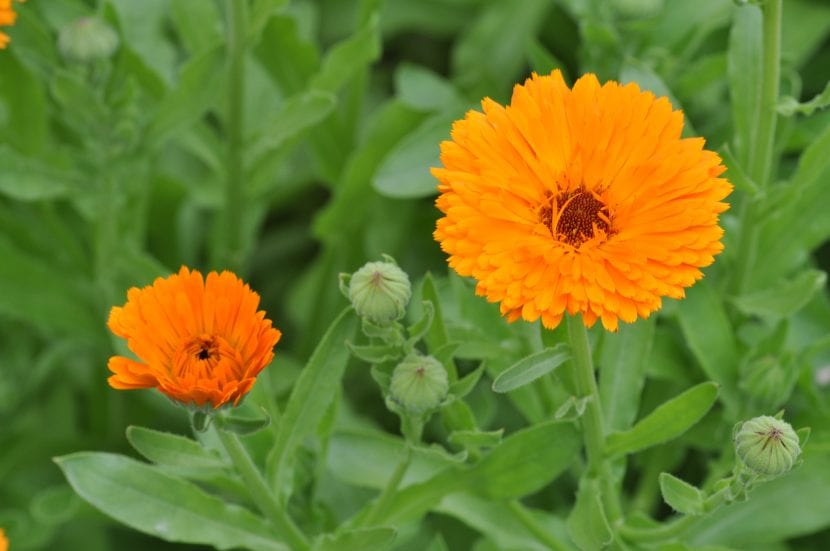
La Marigold it is an annual plant commonly known as Maravilla. This plant produces beautiful flowers with very bright colors such as yellow or orange. The flowering Calendula lasts most of the year: for months this beautiful plant delights us with its beautiful flowers, some have not yet withered and new ones are already emerging!
This plant is certainly a marvel, since it not only makes us happy with its abundant flowers, but also, its leaves provide a delicate smell and have a soft texture.
Calendula Characteristics

This beautiful plant, whose scientific name is Calendula officinalis, it is an aromatic herbaceous with an annual or perennial cycle depending on the climate it belongs to the botanical family Asteraceae. Besides wonder, it receives other names such as buttercup or mercadela.
Its stem grows upright, reaching a height of between 20 and 55cm. The leaves are alternate, simple, oblong-lanceolate and between 7 and 14cm long and 1 and 4cm wide. The flowers, which sprout during the spring, summer and can also do it in autumn if the weather is mild, are grouped in inflorescences in 3-5cm wide chapters, and are yellow-orange.
The seeds are very small, about 1cm, are C-shaped and brown in color.
Cultivation and care
How to cultivate it?

It is a plant that looks so good in gardens and in pots, that having one in the home is wonderful, and never better. To get it, you can go buy it at a market or a nursery. Today for 1 euro you can have an adult already with flowers, but ... What if I told you that for the same price you can have a dozen (at least)?
Of course you have to sow them in spring, and that is done in the following way:
- First of all, you have to choose what you will use as a seedbed: a seedling tray, a flowerpot, peat tablets, milk containers, yogurt glasses, polystyrene trays ... You can use anything, but you have to make sure that it has - or that you can make - holes for it water drainage.
- Now You must fill -if applicable- the chosen seedbed with seedbed substrate that you will find already prepared in any nursery, or with universal growing substrate more or less to the top.
- Then waters so that the earth is well soaked avoiding waterlogging.
- Then place no more than 2 seeds in each socket or seedbed, so that they are a little separated from each other. If you are using peat or Jiffy pellets, insert only one.
- Cover them with a 0,5cm thick layer substrate.
- Then, water with a spray or place the seedling in a tray and water underneath, that is, pouring the water into the tray and letting the soil absorb it.
- Finally, place the seedbed in an area where it can get sunlight directly.
If you water regularly, preventing the substrate from drying out, the seeds will germinate in 1-2 weeks at a temperature of 20ºC.
Once the plants have a height of about 5cm you can transfer them to individual pots and take care of them as we tell you below.
What care do you need?

Calendula is a very resistant plant that does not require much care. However, if you want it to produce a good amount of flowers, it is highly recommended to take care of it like this:
- Location: you must place it outside, in an area where it is directly exposed to sunlight.
- Irrigation: frequent in summer, somewhat scarcer the rest of the year. Generally, you will need 3-4 irrigations per week during the hottest months, and 2-3 the rest.
- Soil or substrate: it is not demanding, but it is important that it has good drainage. In the case of having it in a pot, you can put a first layer of expanded clay balls before planting it so that the roots do not rot.
- Subscriber: from spring to the end of summer it is highly recommended to fertilize it with a fertilizer for flowering plants following the indications specified on the packaging.
- Multiplication: by seeds in spring.
- Planting or transplanting time: in spring.
- Pests:
- Aphids: they are about 0,5cm long, have wings, and can be yellow, green or brown. They settle on the flowers and newer leaves, deforming them.
To repel and / or eliminate them you can mix 100 grams of nettle in 1l of water and apply with a spray. - Whitefly: they are very tiny white flying insects. They settle on the leaves, which turn yellow as a sticky substance spreads.
To repel them or keep them controlled, you can put a yellow chromatic trap near your plant that you will find in nurseries.
- Aphids: they are about 0,5cm long, have wings, and can be yellow, green or brown. They settle on the flowers and newer leaves, deforming them.
- Management:
- Botrytis: it is a fungus that attacks plants that live in a humid environment. To avoid this, you have to control the risks. In the event that the leaves begin to become covered with a gray mold, the affected parts must be cut and the marigold treated with a systemic fungicide.
- Negrilla: it is a fungus transmitted by aphids. To eliminate them completely, the insects must first be eliminated, either using natural remedies such as those described above or with Neem Oil.
- Rust: leaves and stems will show reddish-brown pustules. You must treat with fungicide at the slightest sign of infection.
- Rusticity: supports up to -3ºC.
Calendula uses

From my point of view, it is one of the best plants that exist, because not only does it make us happy with its radiant flowers, but it also has multiple uses, from culinary to medicinal. She is also an excellent meteorologist, since at night her flowers close to open at dawn, but if they are not open at seven in the morning, it will rain that day.
Culinary
In their culinary uses, its petals stand out as substitutes for saffron and in salads. Formerly it was known as the "poor man's saffron", since it is a cheap plant that provides color to dishes. Currently, this plant is still used as salad dressing, giving it a touch of color, although its taste is a bit bitter.
Medicinal
In traditional medicine it has been used a lot thanks to its healing properties. It is used as an infusion, as an oil or cream and through poultices.
In infusion, it reactivates the blood, it is purifying, help to cure mouth ulcers and it serves to treat liver conditions and bowel disorders. This infusion it is made by boiling a handful of dried or fresh petals in a quarter of a liter of water. This infusion is also used to make baths, that is, you can wash your eyes with it to improve eyesight, for example.
Calendula oil or ointment is used for heal wounds and burns, against inflammation of the veins and for the foot fungus. This is prepared with four handfuls of crushed fresh marigold and vegetable oil. This must be passed through the pan and after boiling it is removed from the heat and covered, leaving it to rest until the next day; then it is reheated and the preparation is filtered to finally store it in a glass jar.

The residues that are generated after filtering the Calendula ointment are used as poultices on the skin. They apply for cure varicose veins, adding these residues on the veins and bandaging them for a few days.
Surely you are already looking forward to having this plant in your garden or in pots at home, do not hesitate, since they are easy to grow. They are plants that adore the sun and do not like humidity very much. So what are you waiting for to get one?
More information - Edible flowers: from the garden to the kitchen
WHEN WONDERS ARE PRUNED
Hello Pilar.
They are pruned after flowering.
A greeting.
Hello, I have a calendula, please help me, it is green on the bottom and brown on the top. I don't water it every day, but if I try to keep the soil moist, let it mix hummus, perlite, fertilized soil, and peat. I took it out in the sun, but when the sun hits it it burns its leaves and I don't know what to do, I would appreciate your advice.
Hi Danielis.
I recommend watering it only when the soil is dry. From what you count, it looks like it has too much water.
If you have a plate under the pot, remove it so that the roots do not get waterlogged.
For now, it is better that it is protected from the sun but in a very bright area. When you start to take out new leaves then you can give it some.
Greetings.